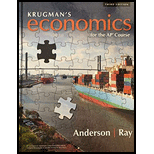
a)
Whether it is another trade-off that can be modeled with a budget constraint when the dilemma of how much money to spend now and how much to set aside for the future occurred.
a)
Explanation of Solution
Yes, it is a trade-off that can be modeled with a budget constraint when the dilemma of how much money to spend now and how much to set aside for the future occurred because a consumer's limited
Introduction: An illustration of possible two-item bundles that a person can buy within their means at the going pricing is called a budget line or budget constraint. These product combos are less expensive than or on par with the consumer's income.
b)
The reason that makes it possible to spend more now than one has.
b)
Explanation of Solution
One major factor for spending more now than one has is cheap credit rating because when there is access to easy financing then, it is a common issue. People exceed the payments for investment projects than the actual calculated cost at that time as they think it is easy for them to pay back.
The second reason can be that many purchases are made on impulse because people made purchases when they are already in the aisles of the store and they influence the purchases without considering their budget factor. Therefore, they ultimately spent more money than they had planned or they have.
Introduction: An illustration of possible two-item bundles that a person can buy within their means at the going pricing is called a budget line or budget constraint. These product combos are less expensive than or on par with the consumer's income.
c)
What one can do to make that amount of money grow in the future when he/she spent less than what they have?
c)
Explanation of Solution
The first thing that one should do to make that amount of money grow in the future when he/she spent less than what he/she has is to create and adhere to a budget. This includes maintaining a realistic perspective on their family's financial status which limits or restricts their more spending than their actual amount of money and offer a growing future. Moreover, building or boosting their emergency fund will also assist them to grow their money or take advantage of that money in the future because they can explore additional investment options in the future by doing this.
Introduction: An illustration of possible two-item bundles that a person can buy within their means at the going pricing is called a budget line or budget constraint. These product combos are less expensive than or on par with the consumer's income.
d)
The rate associated with opportunities that affect the slope of the budget constraints.
d)
Explanation of Solution
The consumers purchasing decisions at different rates are the major factor that affects the slope of the budget constraints as it causes a negative slope that shows the tradeoff. This trade-off is seen as the
Moreover, the scarcity and effects of limited income also affect the budget constraint because a person's income limits consumption. Because if the bundles of two commodities are more expensive than the consumer's income, then they cannot be purchased. As a result, a person's options are constrained by their income, which causes the slopes to be downward.
Introduction: An illustration of possible two-item bundles that a person can buy within their means at the going pricing is called a budget line or budget constraint. These product combos are less expensive than or on par with the consumer's income.
Chapter EMD Solutions
Krugman's Economics For The Ap® Course

 Principles of Economics (12th Edition)EconomicsISBN:9780134078779Author:Karl E. Case, Ray C. Fair, Sharon E. OsterPublisher:PEARSON
Principles of Economics (12th Edition)EconomicsISBN:9780134078779Author:Karl E. Case, Ray C. Fair, Sharon E. OsterPublisher:PEARSON Engineering Economy (17th Edition)EconomicsISBN:9780134870069Author:William G. Sullivan, Elin M. Wicks, C. Patrick KoellingPublisher:PEARSON
Engineering Economy (17th Edition)EconomicsISBN:9780134870069Author:William G. Sullivan, Elin M. Wicks, C. Patrick KoellingPublisher:PEARSON Principles of Economics (MindTap Course List)EconomicsISBN:9781305585126Author:N. Gregory MankiwPublisher:Cengage Learning
Principles of Economics (MindTap Course List)EconomicsISBN:9781305585126Author:N. Gregory MankiwPublisher:Cengage Learning Managerial Economics: A Problem Solving ApproachEconomicsISBN:9781337106665Author:Luke M. Froeb, Brian T. McCann, Michael R. Ward, Mike ShorPublisher:Cengage Learning
Managerial Economics: A Problem Solving ApproachEconomicsISBN:9781337106665Author:Luke M. Froeb, Brian T. McCann, Michael R. Ward, Mike ShorPublisher:Cengage Learning Managerial Economics & Business Strategy (Mcgraw-...EconomicsISBN:9781259290619Author:Michael Baye, Jeff PrincePublisher:McGraw-Hill Education
Managerial Economics & Business Strategy (Mcgraw-...EconomicsISBN:9781259290619Author:Michael Baye, Jeff PrincePublisher:McGraw-Hill Education





